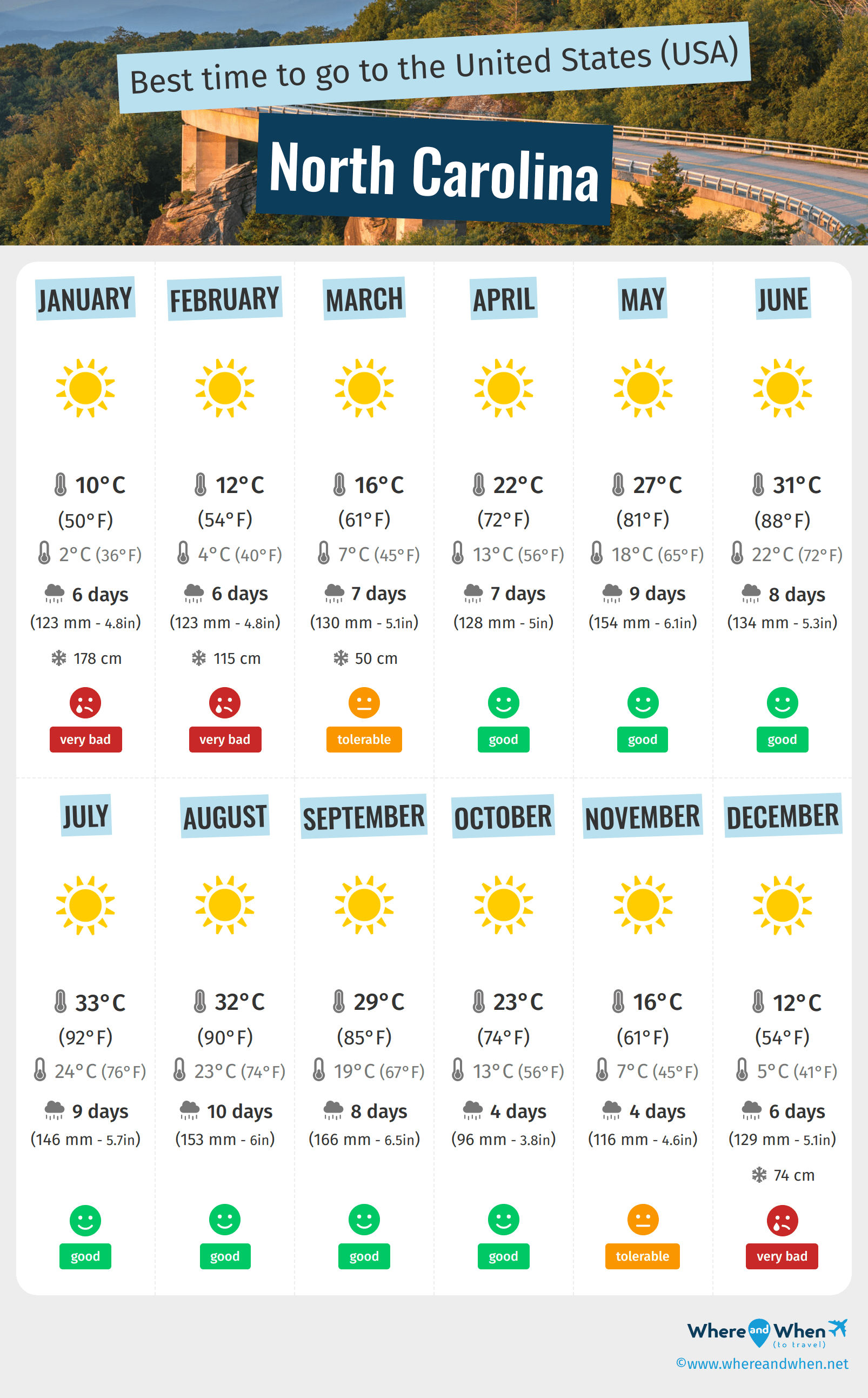Best time to go to North Carolina Average weather of North Carolina, United States
When is the best time to go to North Carolina?
The best time to visit North Carolina, taking into account the weather and climate, is from April to October. This period is ideal for enjoying favorable weather and pleasant temperatures, ranging from mild to warm. Additionally, spring (April and May) and fall (September and October) offer more moderate temperatures, perfect for outdoor activities such as hiking or visiting natural parks.
If you prefer sunshine and higher temperatures, the months of June, July, and August are perfect for you. This is also the peak tourist season in North Carolina, meaning that tourist sites will be livelier and you can enjoy numerous events and festivals.
Visiting North Carolina during the peak tourist season has its advantages. For example, you can enjoy the lush spring blooms or the explosion of autumn colors. Additionally, the beaches are particularly attractive during the summer, with abundant marine life and water temperatures ideal for swimming.
However, consider planning a trip in March, despite potentially more unpredictable weather. It is the beginning of the peak tourist season, allowing you to avoid crowds while experiencing the awakening of spring.
Finally, if you are considering visiting North Carolina outside of these periods, know that each season has its own charm. Winter, for example, can be an interesting time for winter sports enthusiasts in the western mountains of the state.
In summary, North Carolina is an attractive destination year-round, but the best time to visit, considering both the weather and tourist traffic, is between April and October.
So, when is the best time to go to North Carolina? Here's some more information to help you in your decision:
- The best months for good weather in North Carolina are April, May, June, July, August, September and October
- On average, the warmest months are June, July and August
- January is the coldest month of the year
- The rainiest months are May, June, July, August and September
Annual weather in North Carolina

Weather details in North Carolina month by month
Weather and climate in North Carolina
North Carolina, located on the east coast of the United States, benefits from a humid subtropical climate. This type of climate, characteristic of temperate regions, features marked seasonal variations, without a true dry season, and often a hot summer. The months range from cold and humid winters to hot and humid summers, with a gradual transition in spring and fall.
Winter in North Carolina (December - February)
Winter in North Carolina can be quite harsh, with daytime minimum temperatures dropping to 2°C in January. Precipitation is frequent, contributing to a generally unfavorable climate for outdoor activities. However, the sky can clear on some days, offering a few hours of sunshine.
Spring in North Carolina (March - May)
Spring marks a gentle transition, with temperatures gradually starting to rise. In May, the maximum temperature reaches a pleasant average of 27°C. Precipitation remains constant, but the region enjoys an increasing number of sunny days.
Summer in North Carolina (June - August)
Summer in North Carolina is generally hot and humid, with maximum temperatures reaching 33°C in July. The precipitation rate remains high, contributing to the overall humidity. However, the region also benefits from a significant number of sunny days, offering great opportunities to enjoy the beaches and outdoor activities.
Fall in North Carolina (September - November)
Fall sees a gradual drop in temperatures, with still pleasant values in October, where the maximum temperature averages 23°C. Precipitation starts to decrease, and the number of sunny days remains high, making this period particularly conducive to visiting the region.
In conclusion, North Carolina offers a varied climate, with cold and humid winters, and hot and humid summers. Spring and fall are pleasant transition seasons, with moderate temperatures and a good amount of sunny days. Plan your visit according to your climate preferences to make the most of your trip.

Charts: temperature and rainfall in North Carolina
In the charts below, you can see the following seasonal norms for the city of North Carolina: the minimum and maximum outdoor temperature, the risk and amount of monthly rainfall, daily average sunshine, and relative humidity for each month of the year.
Outside temperature
Precipitation (rainfall)
Daily sunshine hours
Humidity
Other cities and places near North Carolina
Best time to go to the United States (USA)











































































































 North Carolina
North Carolina
 other locations
other locations









